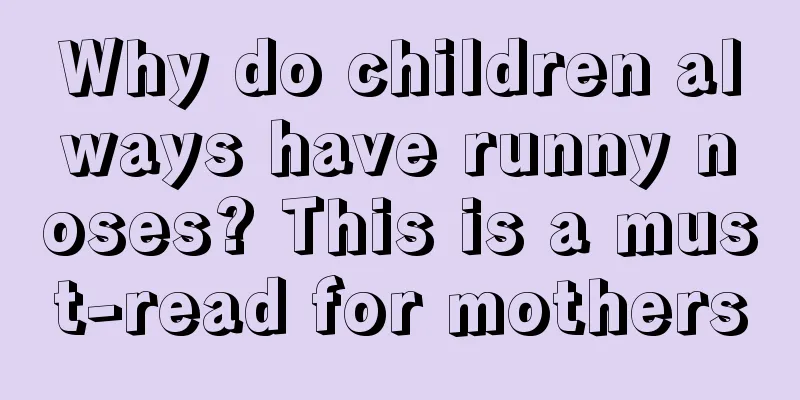Hypoglycemia convulsions in children

|
Many children are prone to symptoms of hypoglycemia when they are very young. Because their own resistance and immunity are relatively low, their blood sugar is prone to low. Once their blood sugar is relatively low, they are prone to convulsions. Therefore, parents must pay attention to their children's physical changes, especially the need to measure their children's blood pressure and blood sugar regularly. What should I do if my child has hypoglycemia convulsions? Hypoglycemia convulsions in children Too little glucose production ① It occurs in premature infants and infants smaller than gestational age, and is mainly related to insufficient storage of liver glycogen, fat, and protein and low glycogenolysis; ② Sepsis, cold injury, and congenital heart disease are mainly caused by insufficient calorie intake, high metabolic rate, increased sugar requirements, and low gluconeogenesis; ③ Congenital endocrine and metabolic defects often cause persistent and stubborn hypoglycemia. Increased glucose consumption It is more common in infants of diabetic mothers, Rh hemolytic disease, Beckwith syndrome, asphyxia and infantile islet cell hyperplasia, all of which are caused by hyperinsulinemia. Pay attention to whether there is family heredity, maternal diabetes and gestational hypertension, pay attention to the age of onset, and the birth weight, placental condition, family heredity history, maternal diabetes and gestational hypertension syndrome history of newborns should be understood. Pay attention to the causes and characteristics of hypoglycemia, such as cold and hunger. Birth trauma, hypoxia, asphyxia, infection, neonatal hemolytic disease, use of ethanol, salicylates and other blood sugar-lowering drugs. Does the child hate fruits or sweets? Does he often vomit or have diarrhea after eating? Does he have a high-protein diet or feeding? Is there any connection between it and the onset of the disease? Does the disease often occur in the early morning on an empty stomach? Pay attention to any suspicious symptoms of hypoglycemia: such as irritability, drowsiness, poor sucking, weak crying, apnea, paroxysmal cyanosis, abnormal eye movement, redness, pallor, weakness, sweating, fatigue, muscle weakness, headache, dizziness, diplopia, tremor, fainting, tachycardia, confusion, speech disorders, convulsions, coma and mental confusion, etc. What to eat for children with hypoglycemia Parents should choose fruits, vegetables, cereals, various legumes such as peas and beans, some meats and fish for their children. High-sugar, high-protein diet, and small, frequent meals. For hypoglycemia caused by congenital metabolic disorders, such as galactosemia or fructose intolerance, milk should be stopped and lactose-free foods should be given. People with fructose intolerance should avoid sucrose, sweets or fruits and adopt a fructose-free diet. Ketogenic hypoglycemia is treated with high-protein, high-carbohydrate, multiple meals. People who are allergic to leucine should eat carbohydrates as their staple food and limit leucine foods (such as milk and eggs). For type I glycogenostasis disease, fructose and galactose are removed from the food, and starch, maltose and glucose are given as multiple meals. If necessary, feeding is done through a nasogastric tube at night (the heat energy is 1/3 of that during the day); type III should use high-protein and high-carbohydrate foods. Avoid eating easily digestible carbohydrates or foods with a high glycemic index, because high-glycemic foods are absorbed quickly and can cause blood sugar to drop rapidly after a period of time, causing the body's blood sugar to drop. Children with mild attacks and clear minds can also see rapid results after being fed glucose water, fruit juice, sweet rice soup, etc. |
<<: What medicine should I use for my child's allergy?
>>: Children's fever and convulsions medication
Recommend
Causes and solutions for bubbles in newborn baby's stool
There are bubbles in the newborn's stool. Man...
What should I do if my child has a fever after eating eel?
If your baby is usually lively but suddenly becom...
What kind of milk is not suitable for children
Milk is a food we are very familiar with. It is r...
Reasons for loose yellow stools in newborns
The care for newborns must be meticulous. If the ...
Can a child heal himself if he lets out gas?
Careful parents will notice that their children o...
Diet therapy for neonatal genetic metabolic diseases
In fact, many babies nowadays have very poor phys...
How to clean baby eczema with honeysuckle
I believe everyone must be very familiar with the...
What are the treatments for respiratory infections in children?
Since children's resistance is often weak, ma...
How to discharge amniotic fluid from the stomach of newborns
If a child accidentally inhales amniotic fluid wh...
Baby nails are purple
I recently saw a special interview on TV. There w...
Nursing measures for children with hemp
Urticaria is a very complicated disease. If you s...
What to do if your child has a picky eating habit?
Children are lovable elves, and everyone likes ch...
What are the good foods for children to eat to supplement nutrition?
Children need to supplement a lot of nutrition to...
The difference between roseola infantum and allergies
Children are very prone to skin diseases when the...
What are the effects of drinking coffee on children?
Coffee is a very common drink in our daily lives,...









